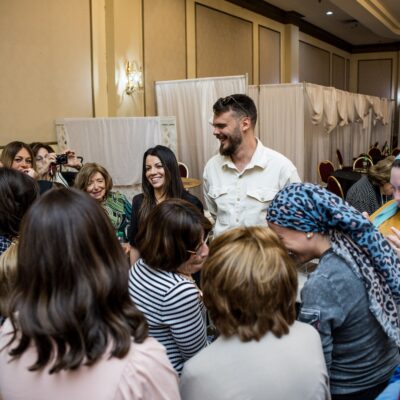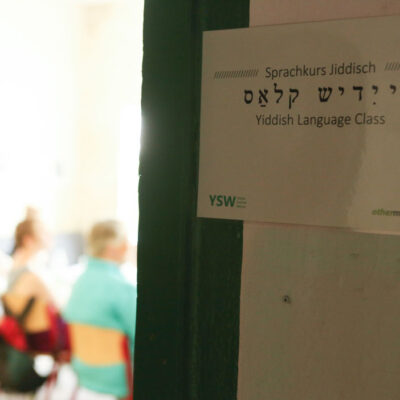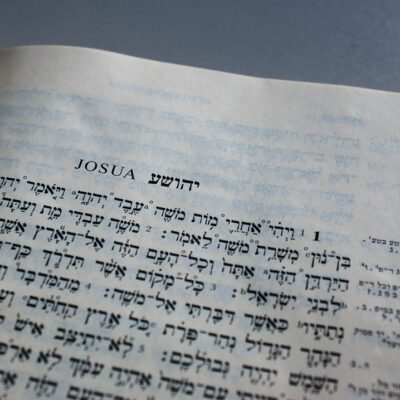NO DIRECTION HOME
Kiryat Shmona Mayor Avichai Stern discusses the evacuated city’s untenable present, uncertain future
Since the start of the war, Israel's northernmost city has been hit by hundreds of rockets, missiles and drones, as its displaced residents have been scattered throughout the country

Scott Peterson/Getty Images
The largest town in northern Israel, Kiryat Shmona, is seen practically empty on Dec. 8, 2023.
KIRYAT SHMONA, Israel — As we made the short drive from city hall to his home in this city just over a mile from the Lebanese border, Mayor Avichai Stern pointed out some of the buildings that have been hit by rocket and anti-tank guided missile attacks.
“A missile hit there,” Stern said, pointing at one building next to the northern Israeli town’s main shopping mall. “The Soldier’s House [a civilian-run hostel for troops] was hit twice. You see the damage there to the wall? It doesn’t stand out so much now — if you didn’t know to look, you might not see it — but the whole city is like that.”
He proceeded to rattle off the statistics: “Since Oct. 7, we’ve had something like 370-380 impacts, but that’s after counting the interceptions. In terms of the total number of rockets and missiles launched at us, it’s more than 4,000… Our warning time [the time between a siren sounding and impact] is supposed to be 10 seconds. In practice, a lot of times the rocket strikes and only then does the siren start.”
In light of these threats and the prospects of even wider conflict, for the past six months, Kiryat Shmona — Israel’s northernmost city — has been a ghost town. Its population of just under 25,000 people has been dispersed throughout the country — with most of the residents spread out among some 230 hotels from the relatively nearby city of Tiberius all the way down to Eilat. According to Stern, roughly 3,000 people, on average, still live in the city, most of them critical workers. The rest, he said, are older people who can’t or won’t leave their homes and people with disabilities who would similarly struggle to pick up and move.
The city streets on Wednesday morning were almost entirely empty, save for a handful of municipal employees doing maintenance work and small groups of soldiers stopping on the side of the road for a coffee or a cigarette. Nearly all businesses were closed, except for those catering to soldiers and drivers passing through, and the cars parked on the side of the road were covered in a thick carpet of dust, fallen leaves and flower petals.
Stern, 38, has served as mayor since 2018 and will continue to do so for the foreseeable future as the municipal elections scheduled for last October have been postponed because of the war. He too has been displaced by the war; he and his wife and two young daughters have relocated to Caesarea, over an hour away.

By far the most frustrating thing for Stern is that there is no indication of when this situation will change. For now, the evacuation order for Kiryat Shmona and the other communities adjacent to the Lebanese border continues through July 7. After that is a mystery.
“We hear nothing [from the government]. No one is going to tell us when [the Israeli military is going to strike Hezbollah],” he said. “They say, ‘If we publicize when we are going to attack, then the enemy knows it too’… We understand that explanation; there’s logic to it. But on the other hand, when you keep up that uncertainty for the enemy, you are also being uncertain with us.”
While the fighting within the Gaza Strip continues, attacks from the enclave at nearby Israeli communities have all but stopped as the Israeli military has significantly impaired Hamas’ and other terror groups’ ability to launch them. This has allowed residents of Gaza border towns to return to their homes and at least begin the arduous reconstruction process.
Not so in Lebanon, where the Hezbollah terror group has overwhelmingly retained its offensive capabilities. While the Israeli military strikes Hezbollah targets in response to attacks, these are limited in scope, aimed at retaliating but not escalating the conflict to a full-fledged war while diplomatic efforts are made to stop the fighting.
This is because even the most hawkish advocates of such a large-scale conflict agree that a war with the Iran-backed terrorist army would be punishing — certainly more so for Lebanon, a country that for years has been on the brink of total collapse, but still devastating for Israel as well at a level that the country, even after Oct. 7, has never seen before.
Despite this threat, there are those — Stern among them — who nevertheless call for Israel to launch a full-scale operation against Hezbollah, believing that no diplomatic agreement would prevent the terror group from eventually carrying out an Oct. 7-style invasion of northern Israel and that Hezbollah would only use the cease-fire to better prepare itself.
Stern noted Hezbollah’s growth over the nearly two decades since the 2006 Second Lebanon War, at a time when there was a cease-fire agreement — U.N. Resolution 1701 —in effect that was meant to keep Hezbollah away from the Israeli border, but has not been enforced.
“It could fire 1,000 rockets a day; now it’s 4,000 rockets a day,” he said. “I take no joy from war. Obviously, we will pay a dear price in a war, even a very dear price. But if we don’t pay that price now, I don’t want to think about what Hezbollah will look like in 2035.”
Stern’s primary concern is Sept. 1, the start of the Israeli school year.
“If we don’t open the school year here on Sept. 1, it will be a disaster. If people sign up their kids to study for the coming year somewhere else — no one is going to take a student out in the middle of the year. And if you’ve been living out of the city for a year or two, you’ll already be embedded in your [new] community, in the school. Your kid will have friends. And it will be much harder to bring them back,” Stern said.
“But of course you can’t bring them back if the reality doesn’t change. We’d just be back in the Oct. 6 reality,” he said.
In the meantime, Stern and city officials are forced to provide services to the Kiryat Shmona residents who have been scattered throughout the country.
“I have 25 social workers, but that’s 25 social workers who need to be in 230 hotels. Each hotel should have its own social worker! It’s unbearable, but there’s no choice,” he said.
Stern stressed that those social workers are needed now more than ever. While schools have started up for the evacuees, attendance rates — particularly for teenagers — are perilously low. In the best circumstances, he said, they are skipping school in order to get jobs, while in the worst cases, they are dropping out to drink, use drugs and gamble. Rates of domestic violence have also risen among evacuees nationwide, exacerbated by unemployment and cramped living conditions.
The municipality divided the country into six regions, with a different employee responsible for each one, and every work day begins and ends with a group Zoom call in which they report on how things are going in their region, Stern said.
He noted that the entire Kiryat Shmona municipality, which employs approximately 200 people, does not have enough staff to have a representative in every hotel.
With no government funding available, Stern turned to philanthropy to fund hiring community organizers. “We went to a few foundations — the Shahaf Foundation, [Stella and Yoel] Carasso’s Beyachad Foundation, [the Jewish Federations of Canada’s] Magbit Canada — and brought them together. Each of them put in money, and we collected a fund of NIS 10 million [$2.7 million]. With that, we hired 100 organizers throughout the country,” Stern said.
But that funding, which was budgeted to last through the end of the current evacuation order, will dry up this summer. “If you ask me what happens on July 7, I don’t have an answer,” he said.
Stern said this reliance on philanthropy has been a constant since Oct. 7, as the country’s focus — justifiably, he stressed — has been on southern Israel.
“I’m not complaining about it. It shouldn’t sound like a complaint, it’s just a fact that everyone was focused on the south,” he said. “But the needs here have only grown, and the state is just not involved. Everything that we have succeeded in doing — setting up schools and day care centers and creating our [six] regions, all of that infrastructure — it is only thanks to philanthropy,” he said.
Stern noted an initial, significant donation in the early days of the war from UJA-Federation of New York.
“[Itzik Shmuli, the head of UJA-Federation of New York’s Israel office] gave me NIS 1.5 million ($400,000), without even asking me, ‘What do you need?’ He just said, ‘Here, take NIS 1.5 million, and get to work,’” Stern recalled. “That gave me air to breathe. If he hadn’t done that, I don’t know where we’d be today.”
Stern laments that even now as the fighting in Gaza has — at least for now — cooled down, there is little public interest in Israel’s northern border crisis.
“[On March 28,] there was the largest ever rocket barrage at Kiryat Shmona and someone was killed — they didn’t stop the normal television broadcasts. There was still the [reality singing show] ‘A Star is Born’ or whatever’s on television,” he said.
But Stern said that while the current struggles the municipality is facing are considerable, the “real challenge” will be reconstruction once the war is over.
“There’s a survey that shows that 40% of the residents [of Kiryat Shmona] won’t return. That was an academic survey conducted by Tel Hai College. It sounded exaggerated to me: 40%? How can that be? Maybe it’s 20-25%,” Stern said. “So I sent out our own survey. Over 900 people responded, with their names. Of them, 13% said they wouldn’t return no matter what. Another 28% said it depended on if Hezbollah went north of [Lebanon’s] Litani River. Put those two together, and you get to basically the same number.”
The war and the evacuation came just as Kiryat Shmona — a city that has struggled financially for decades — was starting to see some returns on recent investments that it had made.
Tel Hai College was on track to become a full-fledged university; a new rail line was due to be installed; and an ambitious plan to turn the city into a hub for “food technology” was just beginning to bear fruit. In recent years, the city was also starting to see population growth, after years of stagnation and even reduction as residents sought better opportunities in the center of the country.
If 40% of the population doesn’t return, that could in turn trigger a wider flight from the area.
“If one of the people [who leaves] is a physics teacher — and there’s a shortage of physics teachers throughout the country, so they’d have no trouble finding a position in Tel Aviv, which probably pays better — you need to find a new physics teacher for Kiryat Shmona, otherwise 30 more families are going to leave because their kids can’t learn physics,” Stern said, as an example.
But Stern and the rest of the city leaders can’t even seriously begin to plan for the “day after” the war because they have no idea what it will look like.
“If the ‘day after’ is like the current situation, then the main challenge will be in rehabilitating that 40% of the population [that doesn’t return], but if it comes after a terrible war, then it’s possible that we’re facing two to three years of just fixing the physical damage,” he said.
And yet Stern insists that even if the price is a terrible war, it is a price he believes that the country needs to pay in order to bring stability to the region.
“I don’t know if we have American support for that. Maybe we have American support for another [U.N. peacekeeping] force and another agreement, but not to wipe [Hezbollah] out, and we have to wipe them out,” Stern said. “Otherwise I am mortgaging my daughters’ future and the future of everyone who lives here. Because the day will come when another Oct. 7 happens. It’s not a question of if it will happen but when it will happen.”













